Photos with this report (click to enlarge) | |||
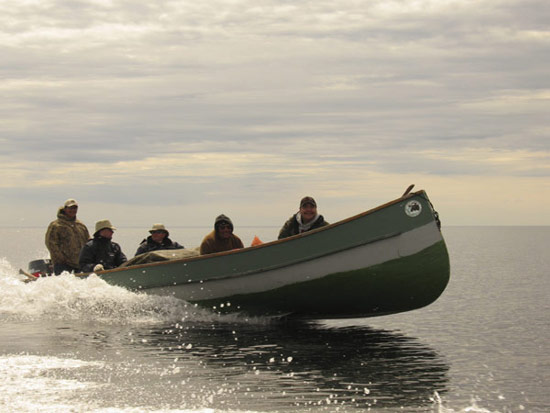 Freighter Canoe |
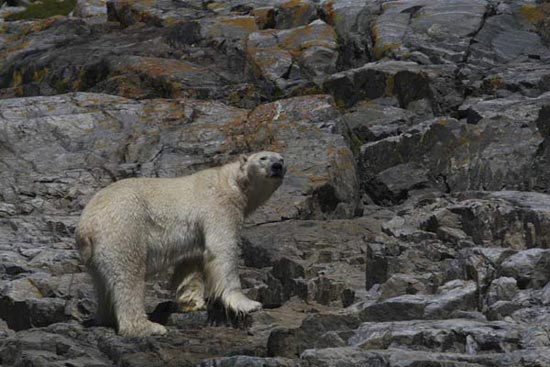 Polar Bear |
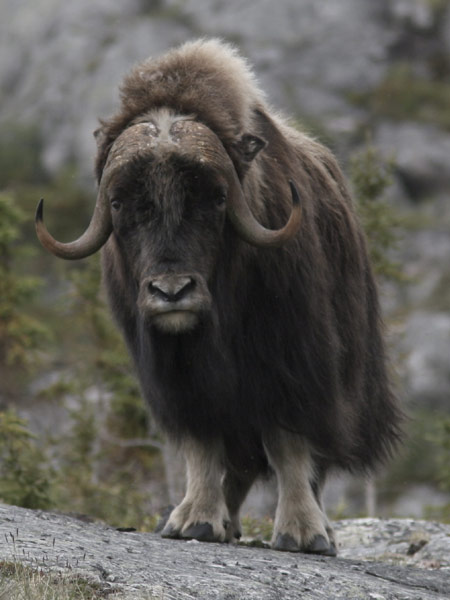 Muskox |
|
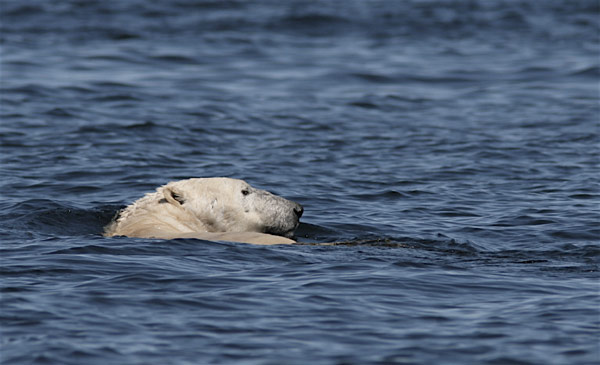 Polar Bear |
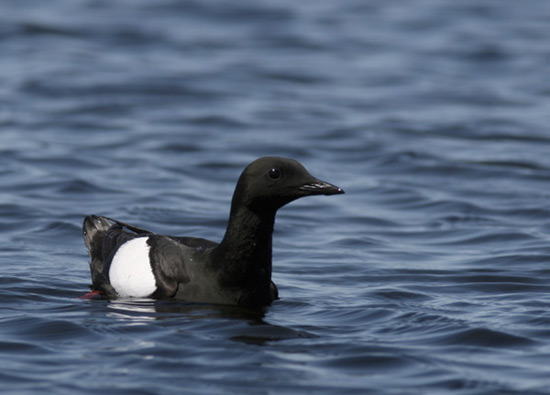 Black Guillemot |
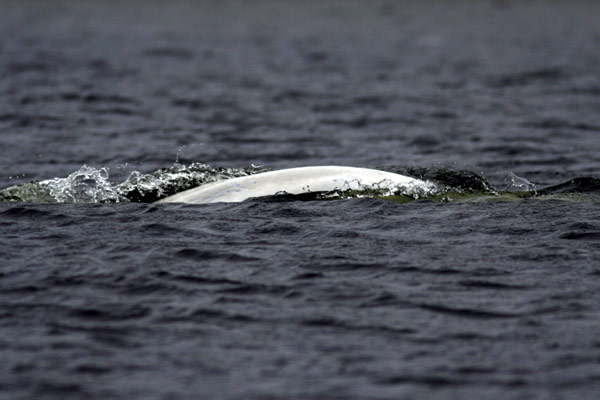 Beluga Whale |
|
Birds, Bears, Belugas - James Bay and Hudson Bay, Nunavut, Canada - July 2006
Paul Jones - Ottawa, Canada
From July 10 to July 24, 2006, I traveled up the northeast coast of James Bay into Hudson Bay, exploring Canada’s north. The birding was good and the mammal-watching outstanding.
Birding - The attraction of the region lies in its remoteness, beauty and, less nobly, its access to southern Nunavut for bird-listing purposes. While most of Canada’s newest territory is characterized by arctic avifauna, the James Bay and lower Hudson Bay islands offer the chance to see forest species. We came across Boreal Chickadee, Gray Jay, Yellow, Yellow-rumped and Wilson’s Warbler, as well as White-crowned, White-throated, Fox and Lincoln’s Sparrow. Northern species sighted included Pacific Loon, Willow Ptarmigan, Purple Sandpiper, Arctic Tern, Lapland Longspur and Common Redpoll. We encountered three active Peregrine nests and numerous tern and eider colonies. For purely listing purposes a trip south into James Bay, rather than north into Hudson Bay, would have been better, as bird diversity is greater in the relatively lush forests of the southern bay islands. The venture north offers arctic landscape and better mammal watching.
Itinerary - Our voyage started at Chisasibi (pronounced chuh-sass-ibby), a Cree community on the east coast of James Bay. Chisasibi is accessible by paved road and is a day and a half, 1,300 kilometre, drive from Ottawa. It can also be reached by air from Montreal. From Chisasibi we headed north by motorized freighter canoe along the James Bay coast, intending to reach the Belcher Islands, an archipelago in southern Hudson Bay. Ice conditions foiled this plan, so instead we followed the open inshore coast of Hudson Bay as far as the Richardson Gulf on the Ungava Peninsula. In total we traveled over 700 kilometres by canoe, setting camp at eleven different locations.
Land and Water - Hudson Bay is a huge inland sea in northeastern Canada, joined to the Arctic and Atlantic oceans by a series of narrow straits. James Bay is its smaller southern appendage. Ice on both bays starts to break up in June. South of Chisasibi the mainland and islands are covered by boreal forest. North of the community the vegetation thins out into treeless tundra and rock. By a quirk of political geography the islands and offshore waters of Hudson and James Bay do not belong to the adjoining provinces of Ontario, Manitoba and Quebec but rather are part of Nunavut, Canada’s newest territory.
Transportation - Chisasibi is reachable by ordinary car. On the water, our expedition traveled by freighter canoe - eight metre, square-sterned boats fitted with 60-90 horsepower outboard motors. The canoes can carry a great deal of freight as well as five to six passengers. They move fast – 25-30 KPH - and handle waves well, although the guides would not take them out if the winds were blowing whitecaps. Even in relative calm, spray still came on board so rain gear was mandatory and all baggage was stored under tarps. Tidal action meant that the boats sometimes had to be hauled up and down rocky beaches at both landing and launching.
Health and Safety - The icy northern waters presented the main danger. I wore an insulated floater jacket (http://www.mustangsurvival.com/products/) in the canoe at all times. It might have allowed me to reach land in event of a near shore capsize and certainly would have assisted with body recovery (hypothermia typically strikes before drowning). The second concern was Polar Bears. At the time of our travel the winter ice was just breaking up and there was the potential for bears to come ashore anywhere. The guides usually carried guns and they adopted an air of extra alertness on off-shore islands. I had a large canister of capsaicin (pepper spray) bear repellent. Our one Polar Bear encounter - a safe, close and awe-inspiring experience - reminded us that our caution was warranted.
The area is very remote so the expedition carried two satellite phones to stay in touch with the outside world. The guides were also very risk conscious, traveling only when weather conditions were appropriate and all gear in working order. They were not going to risk damage to their boats and motors or injury to themselves. As we gradually came to be aware, they also carried a heavy sense of personal responsibility to ensure our safety.
Clothing - Summer can be cold, windy and wet on the bay islands. At night temperatures drop below ten degrees and even during the day it is still very chilly on the water. Lots of warm layers are a good idea. A rain jacket, rain pants and gloves are an absolute necessity as salt spray and regular rain showers create a constant struggle to stay dry. High rubber boots ensure dry feet when jumping in and out of the boats and a pair of hikers is useful on the rocky islands. Having a bug jacket and insect repellent is a good idea too. Mosquitoes were not a problem on the windswept outer islands but were thick in sheltered areas.
Equipment - Traveling light is recommended because everything has to be packed in and out of the canoes at each new camp site. A tent, sleeping bag, foam mattress, extra clothes, water filter and kit bag comprised the bulk of my gear. A small folding stool, pocket knife and flashlight were also useful. To keep my gear dry, I carried it in two Sealine waterproof bags (70L and 115L). The north is hard on equipment, with the salt damp and constant rough loading and unloading of the boats, so quality material is essential, especially tents that can handle gale-force winds on barren rock outcrops. You must have a life vest or better yet, a floater jacket.
Logistics - Our expedition was planned through Sherman Herodier, tourism authority officer at the Chisasibi Mandow Agency (http://www.mandow.ca/). His work number is 819 855-3373. Sherman arranged for two canoes and guides with knowledge of the waters north into Hudson Bay. One canoe was piloted by brothers Moses and Abraham Snowboy. Freddy Scipio and his son Thomas and nephew John guided the other. At the last minute Sherman was able to come along as well. I cannot speak highly enough of the skill, integrity, patience and friendliness of this group. That said, the expression “I’ve got a feeling we are not in Kansas anymore” applies very strongly to Chisasibi.
With the collapse of the fur-trapping economy and the flooding of massive areas of traditional hunting areas by Hydro-Quebec, the Cree are now undergoing a rapid transition to urban life. The Mandow Agency is part of an effort to build a tourism economy. The birthing pains of the new industry were evidenced by events such as their sudden concern over the feasibility of our trip a week before the scheduled start time. This proved to be a minor setback as patient discussion soon got things up and running, but it did underline the uncertainty that attaches to travel in the area and the need to be conscious of cross-cultural communication issues.
Costs - Each canoe, with two guides, ran $250 per day for a daily total of $500. There was no extra charge for the two additional guides (Thomas and John Scipio) who joined us. The canoe/guide fee did not include gas, which added another $1,200. With food, travel to Chisasibi and other miscellaneous expenses, the trip cost the five southern participants approximately $2,500 each. A portion of the total cost was paid upfront, the remainder (including an appropriate tip) at the completion of the voyage.
Food - We brought a selection of freeze-dried, smoked, canned and otherwise packaged pastas, meats, biscuits, soups and spices, subdivided into individual breakfasts, lunches and dinners. Most of it was cooked on an open fire, although we did have a small camp stove as well. The Cree had store-bought food and a gill net and a selection of rifles and shotguns with which to live off the land. They were also able to obtain various meats from other hunting parties we met on the journey. By these methods Porcupine, Common Loon and Beluga Whale, as well as copious amounts of trout and white-fish, were added to our diet. We also gathered and steamed mussels, which we found in abundance on rocky island shores.
Chronology
July 8 - Ottawa to Amos - Depart Ottawa early, drive north to Amos, Quebec – an easy 500 kilometre, five hour drive.
July 9 - Amos to Radisson - Depart Amos at dawn for Radisson, an 800 kilometre, eight hour journey through long stretches of Jack Pine boreal forest. The land is empty and flat, but still subtly beautiful. The highlight was a Gray Wolf 50 kilometres south of Radisson. Birds seen from the car included Spruce Grouse, Black-backed Woodpecker, Gray Jay and White-winged Crossbill. We also found a singing male Connecticut Warbler near the start of the James Bay Highway. Note: gas up in Matagami at K0 of the Highway (http://jamesbayroad.com/jbr/index.html) and again at K381, the next gas station and the location of a friendly restaurant.
July 10 - Radisson to Chisasibi to Long Point (53°58'25.81"N - 79° 4'39.84"W) - From Radisson we made the short drive to Chisasibi and met Sherman Herodier at the Band Office Building to finalize plans for our journey. Sherman instructed us to drive to Long Point, a promontory north of Chisasibi on the James Bay coast, camp, and watch for the arrival of the canoes at noon the next day.
July 11 - Long Point to Long-tailed Duck Island (54° 4'31.03"N - 79°14'53.60"W) – At nine the next evening Sherman and the crew showed up, having been trapped in Chisasibi by onshore winds. This served as an early introduction to how weather dependent travel would be. Leaving our vehicles at Long Point, we loaded the canoes and began the journey north. At 10 p.m. in the gathering dusk we made camp at “The Place Where we used to Hunt Long-tailed Ducks Island”.
July 12 - Long-tailed Duck Island to Long Island (54°50'52.06"N - 79°23'46.99"W) – We awoke early and birded around the camp. Although mostly tundra and rock, the island had small stands of spruce which held Yellow Warbler, White-crowned, White-throated, Fox and Lincoln’s Sparrow. Locating and birding such pockets of forest became a key tactic. Boarding the boats at 9 a.m. we proceeded north along the coast. Our pilot, Moses Snowboy, pointed out landmarks and would occasionally break into a quiet Cree song about the various locations we passed where his family had hunted and camped in years gone by. At noon we rounded Cape Jones, the demarcation point between James and Hudson Bay and the site of an abandoned military radar station. After examining the crumbling installation and enjoying a shore lunch of trout and whitefish, we made our way to our second camp on the east side of Long Island in Hudson Bay.
July 13 - Long Island to Great Whale (55°16'43.86"N - 77°45'25.49"W) – At 55 degrees north, it’s hard to awake before dawn in July, but I got up as early as I could and commenced a long hike. Directly behind our camp there was a Peregrine nest on a low cliff. Farther afield I found an Arctic Fox and families of Pacific Loon, Horned Lark and American Pipit. The land was treeless, windswept and desolate, with scattered signs of ancient inhabitation including cairns, empty stone food caches, tent rings and fire pits. After helping our guides pull the gill net (yielding a few whitefish) we broke camp late morning and journeyed up the sheltered Long Island Sound and through a narrow passage to the open water of Hudson Bay. Our destination was Great Whale (AKA Kuujjuaraapik and Whapmagoostui) a mixed Inuit/Cree community at the mouth of the Great Whale River. Pack ice was visible on the horizon, and as we got closer to Great Whale we began to encounter it in drifting floes, melted into strange shapes by the wind and waves.
July 14 - Great Whale – We stayed two nights in Great Whale, first at the pleasant but expensive hotel and then in a community hall graciously made available for us. At first appearances the village is rather bleak, but the people were friendly and very interested in our voyage. In our discussion with the locals we learned that the Belcher Islands (our destination) were still iced-in, putting them out of our reach. As Great Whale represented the northern limit of our guides’ navigation comfort zone, another guide joined our party. Josee would lead us north to an alternate destination – Richardson’s Gulf – a large saltwater “lake” joined to Hudson Bay by a narrow passage.
July 15 - Great Whale to Duck Island (55°45'3.48"N - 77°13'44.63"W) – From Great Whale we proceeded north through the protected water of Manitounuk Sound, crossing through the barrier islands at “Boat Opening” to Hudson Bay. Our day’s destination was Duck Island, a low outcrop of sand and rock approximately eight kilometres from the mainland. Heavy fog limited birding on the island, but we still managed to locate a number of shorebirds including Semipalmated Plover, Black-bellied Plover and Least and Purple Sandpiper. Camp duties, including gathering firewood and water also occupied our time. Finding drinking water on the bay islands can be a challenge and we often had to resort to carefully filtering the contents of small stagnant pools. For fire we burned the driftwood we found in varying quantities along the shore.
July 16, 17, 18 Little Whale River (56° 0'8.85"N - 76°46'12.06"W) - We broke camp late morning on Duck Island, loaded the boats and made our way north along the Hudson Bay coast to Little Whale River. We arrived at mid-day, just ahead of a storm system, and made our sixth camp at the mouth of the Little Whale River, the site of a long-abandoned Hudson Bay Company trading post. Disappointed by our inability to reach the Belchers, we set our tents and prepared to wait out a rising gale. Huddling around the fire for warmth, our spirits rose up when one of the guides returned to camp with a Porcupine he had dispatched with a stick. The Porcupine was placed on the fire to burn the fur and sharp quills away. It was then cut into chunks, which were boiled in a large pot for several hours. Finally, the food was shared out and it tasted very good, reminiscent of lamb.
In mid July a heavy run of andronomous Brook Trout gathers in the estuary of the Little Whale River and begins to move upstream. Fishing with small spinners, spoons and jigs from the beach where the river meets the bay we were able to catch as many of them as we could eat. The Cree encouraged our efforts with polite interest but elected to set a gill net which yielded industrial scale results – which were promptly cleaned, dried and smoked for later consumption. Perhaps attracted by the trout, a pod of 150-200 Beluga Whales also gathered in the estuary. Small groups would break off from the main mass and swim up the river past us, just metres from our feet. Two Black Bear (Ursus americanus) were seen in the vicinity of the camp. The most interesting bird sighting was a family of very noisy Northern Shrike.
July 19 - Little Whale River to Richardson’s Gulf (56° 9'58.65"N - 76°39'4.81"W) to Point Purngavik (55°40'50.23"N - 77°10'5.78"W) - On July 19 the weather calmed enough for us to continue our journey. We proceeded north, hugging the shoreline, and at 56° 9'58.65"N Josee signaled the boats to turn inland. Straining against the out rush of water, the canoes entered a narrow opening in the high coastal cliffs. Once through the passage the scene opened into the vast expanse of Richardson Gulf. Just as we entered the gulf one of the guides said “Muskox!” and pointed to a rocky headland. We landed and walked up to the extraordinary animal, which stood its ground as we approached to photograph it. After a shore lunch and a nap we got back in the boats and began the long trip south. By late afternoon we made the next camp, a sheltered spot on Point Purngavik at the base of the Manitounuk Islands.
July 20 - Point Purngavik to Great Whale - After surviving a tremendous overnight storm, we bailed the canoes, filtered the gas which had become contaminated with water, and continued our journey south, eventually reaching Great Whale. Unable to enter the river because of rough seas, we pulled the canoes ashore just north of the community and set camp for the night.
July 21 - Great Whale to Long Island (54°53'51.23"N - 79° 8'38.00"W) - Awaking late, we ventured into town to purchase supplies. Returning to our canoes, we got back on the water, eventually reaching camp nine near the north tip of Long Island. As the sky darkened a spectacular display of the northern lights commenced, flickering and shifting overhead like the vaulted ceiling of a translucent cathedral.
July 22 - Long Island to Cape Jones (54°37'33.64"N - 79°45'27.96"W) - From Long Island we continued south, planning to check some of the smaller off-shore islands we had hurried past on the trip north. As we approached an islet off the juncture of James and Hudson Bay we noticed two boats pulled up on the beach and a crew of men on the water’s edge. As we approached, the bay became calm, glassy and red. On shore an Inuit hunting party from the community of Umiujaq was working around the bodies of two Beluga Whales they had just killed. The oil emanating from the blubber of the Belugas had set the strange calmness on the water. One of the hunters handed us strips of Muktuk - the glossy white skin and subcutaneous fat of the whale - freshly cut from the kill. It was chewy and had little taste, but was filling. The hunters also gave us a quantity of rich, red meat. We cooked it later that day on an open fire and it tasted very good, like lean filet mignon. Pulling ourselves away from the surreal scene of the kill, we did a quick bird survey of the island, finding Common Eider and Arctic Tern nests and a vagrant passerine – a meadowlark. There are only a handful of meadowlark records for Nunavut, but this one, flushing at distance into a near gale and never observed on the ground, was unidentifiable to species. Boarding the boats and waving good-bye to the hunting party, we continued to Cape Jones where the Snowboys and Scipios maintained a seasonal hunting camp.
Besides provisioning us with whale meat, the Inuit also provided an interesting piece of information. Two days earlier they had seen Nanook on an island just to the north. As the winter ice was receding, Polar Bears were finally coming ashore.
July 23 - Cape Jones to Boot Island - At the suggestion of team member Rob Tymstra, an experienced bay hand, we set out mid morning from the Cape for Bare Island, a small rock outcrop approximately 20 kilometres from the nearest land. Our goal was to see a Polar Bear, as the remote rock was the sort that bears appear on after the ice goes out. Following a GPS bearing we headed across the open water and as the mainland dropped away behind us the small island gradually came into view. With no beach to land on, the canoes were roped to shore in a small rocky bay and the party set off to explore, followed by a hovering crowd of excited Arctic Terns. Freddy Scipio, one of the senior guides, un-shouldered his gun and walked quickly to the highest point of land. Normally very quiet, his urgently spoken “Wabusk” and again “Wabusk” (Cree for Polar Bear) caught our immediate attention. Freddy pointed off the back end of the island where a Polar Bear floated stationary in the bay. Quickly re-boarding the canoes we motored around to get a closer look at the animal. We approached it from a healthy distance and watched awestruck as it swam to the island and climbed ashore. Calmly staring at us, it shook the water from its coat, grabbed an Eider off a nest and sat down to eat it. We were very excited. From Bare Island we headed back towards the mainland and set camp on Boot Island just off the mouth of Seal River.
July 24 - Boot Island to Chisasibi and home - Mid morning we packed up and left Boot Island and began the final leg of the return journey to Chisasibi. A forest fire, visible from many kilometers away and burning at approximately the location where we left our vehicles, caused some concern. On reaching Long Point it was clear the burn was at least several kilometers away from our trailhead. We loaded our vehicles, said a moving goodbye to our guides and began the long drive south.
Closing Thoughts - Special thanks to the guides - Sherman Herodier, Moses and Abraham Snowboy and Freddy, Thomas and John Scipio. Thanks also to Josee and Sonny in Great Whale and to my fellow travelers Matt Aitken, Guy Bennett, Malcom Lawson and Rob Tymstra for inviting me to join their trip. Rob’s site is a goldmine of info on birding the bay islands:
http://www2.ebtech.net/~birdman/index.html
The expedition, or a similar one from Moosonee on the west side of James Bay, is essential for anyone interested in building a Nunavut list. Better than listing, or even birding, was the chance to meet and travel in a remote part of the world with people who had a special connection to the land and water.
Paul Jones - Ottawa, Canada - pauljodiATmagma.ca
Annotated Bird List - James and Hudson Bay islands, Nunavut, July 10 to 24, 2006
Un-numbered species denote sightings of interest seen on the mainland (Quebec).
1. Pacific Loon - Gavia pacifica - seen daily, second commonest loon
2. Common Loon - Gavia immer - seen daily, the commonest loon, tastes like duck
3. Red-throated Loon - Gavia stellata - seen daily in small numbers
4. Canada Goose - Branta Canadensis - seen daily, often in large molt flocks
5. Green-winged Teal - Anas crecca - uncommon
6. Mallard - Anas platyrhynchos - one individual with Black Ducks (see below)
7. American Black Duck - Anas rubripes - one sighting of eight individuals, on Boot Island off Seal River
8. Northern Pintail - Anas acuta - seen daily in small numbers
9. Lesser Scaup - Aythya affinis - both scaup were seen daily, not always identifiable to species
10. Greater Scaup - Aythya marila
11. Common Eider - Somateria mollissima - seen daily, often in large flocks, several breeding colonies visited
12. King Eider - Somateria spectabilis - three individuals on July 13 at northern tip of Long Island
13. Long-tailed Duck - Clangula hyemalis - several sightings
14. Black Scoter - Melanitta nigra – seen daily, often in large groups of 200-300, 90% adult males
15. White-winged Scoter - Melanitta fusca - seen daily, often in large groups of 50-100, 90% adult males
16. Surf Scoter - Melanitta perspicillata - three sightings only, small numbers
17. Common Goldeneye - Bucephala clangula - several sightings
18. Common Merganser - Mergus merganser - one sighting, July 22, Long Island
19. Red-breasted Merganser - Mergus serrator - seen daily
20. Rough-legged Buzzard - Buteo lagopus - several sightings
Merlin - Falco columbarius - one sighting, agitated individual, July 20 at Point Purngavik, QC
21. Peregrine Falcon - Falco peregrinus - three active aeries, occasional other sightings, including a presumed pair cooperatively hunting and killing an Arctic Tern
Spruce Grouse - Falcipennis Canadensis - single tail feather found in spruce stand on Manitounuk Island, also seen along James Bay Highway south of Chisasibi in QC
22. Willow Ptarmigan - Lagopus lagopus - one family group on “Long-tailed Duck” Island, July 12
23. Black-bellied Plover - Pluvialis squatarola - one, July 16, Duck Island – a general note on shorebird sightings: at the commencement of the trip most encounters consisted of individuals engaged in breeding behaviour (flight song, distraction display), later on we began to come across migratory flocks
24. Semipalmated Plover - Charadrius semipalmatus - seen daily, common
25. Greater Yellowlegs - Tringa melanoleuca - common on James Bay islands
26. Lesser Yellowlegs - Tringa flavipes - uncommon on James Bay islands
27. Spotted Sandpiper - Actitis macularia - one sighting on Boot Island off Seal River Island, July 23
28. Whimbrel - Numenius phaeopus - migratory groups apparent towards end of trip
29. Ruddy Turnstone - Arenaria interpres - several sightings
30. Sanderling - Calidris alba – single sighting
31. Purple Sandpiper - Calidris maritime - uncommon on remoter, rocky islands
32. Semipalmated Sandpiper - Calidris pusilla - several sightings
33. Least Sandpiper - Calidris minutilla - commonest sandpiper, frequently seen in flight display
34. White-rumped Sandpiper - Calidris fuscicollis - migratory groups apparent towards end of trip
35. Baird’s Sandpiper - Calidris bairdii - single sighting
36. Pectoral Sandpiper - Calidris melanotos - migratory groups apparent towards end of trip
37. Dunlin - Calidris alpina - single sighting
38. Red-necked Phalarope - Phalaropus lobatus - uncommon, found on small tundra pools
39. Glaucous Gull - Larus hyperboreus - common, seen daily, downy young found at northern tip of Long Island
40. Ring-billed Gull - Larus delawarensis - one sighting, Long Island, July 13
41. Herring Gull - Larus argentatus - common, seen daily, downy young encountered on several off-shore islands
42. Great Black-backed Gull - Larus marinus - commoner than expected, seen most days
43. Arctic Tern - Sterna paradisaea - common nesting colonies frequently encountered on offshore islands
44. Black Guillemot - Cepphus grille - commoner than expected, 30-40 seen daily when traveling in vicinity of offshore islands
45. Short-eared Owl - Asio flammeus - one sighting on island off Seal River, also seen on mainland at Cape Jones and Chisasibi
Black-backed Woodpecker - Picoides arcticus - one sighting on mainland, flying across the James Bay Highway
46. Horned Lark - Eremophila alpestris - uncommon, but still seen daily
47. Boreal Chickadee - Parus atricapillus - single sighting, dense forest only
48. Gray Jay - Perisoreus canadensis - several sightings on more heavily treed islands
49. Common Raven - Corvus corax - seen daily in small numbers
Common (European) Starling - Sturnus vulgaris - small group at Cape Jones, QC, an anomalous sight amongst the tundra and abandoned radar structures
Gray-cheeked Thrush - Catharus minimus - uncommon on the mainland in Chisasibi area
50. American Robin - Turdus migratorius - several sightings in denser forest
51. Ruby-crowned Kinglet - Regulus calendula - two sightings, dense forest only
52. Yellow Warbler - Dendroica petechia - the commonest warbler
53. Yellow-rumped (Myrtle) Warbler - Dendroica coronata - uncommon in denser forest
Connecticut Warbler - Oporornis agilis - one singing male near start of James Bay Highway
54. Wilson’s Warbler - Wilsonia pusilla - single male at south end of Manitounuk Island
55. American Pipit Anthus rubescens - abundant, the signature bird of the barren rock of the north
56. Lapland Longspur - Calcarius lapponicus - uncommon
57. Lincoln's Sparrow - Melospiza lincolnii - one singing male on Long-tailed Duck Island just north of Chisasibi
58. White-throated Sparrow - Zonotrichia albicollis - uncommon in wooded areas on southerner islands
59. White-crowned Sparrow - Zonotrichia leucophrys - common, singing males present in the smallest patches of willow/spruce scrub on bay islands
60. Savannah Sparrow - Passerculus sandwichensis - uncommon in grassy areas
61. Dark-eyed Junco - Junco hyemalis - uncommon in denser forest
62. Common Redpoll - Carduelis flammea - common, seen or heard daily
Annotated Mammal List - James and Hudson Bay islands, Nunavut, July 10 to 24, 2006
1. Gray Wolf - Canis lupus - One sighting approximately 50K south of Radisson on the James Bay Highway, fresh tracks seen at Little Whale River and Boot Island
2. Arctic Fox - Alopex lagopus - One sighting on Long Island on July 13, in summer coat (dark saddle and legs contrasting with grayish white undercoat)
3. Black Bear - Ursus americanus - Two at Little Whale River, July 17 and 18
4. Polar Bear - Ursus maritimus - One, July 23, on Bare Island, Nunavut off Cape Jones
5. Muskox - Ovibos moschatus - One on north shore of Richardson Gulf, it allowed close approach and photography, an extraordinary, prehistoric looking animal
6. American Red Squirrel - Tamiasciurus hudsonicus - Occasional sightings
7. Muskrat - Ondatra zibethicus – occasional sightings
8. Gapper’s Red-backed Vole - Clethrionomys gapperi – occasional sightings
9. Meadow Vole – Microtus pennsylvanicus – occasional sightings
10. Beluga Whale - Delphinapterus leucas – four sightings, one individual in James Bay near Seal River on July 12, a large pod of perhaps 200 animals at Little Whale River July 16-18, a pod of 15-20 animals in the Manitounuk Sound on July 20, two animals freshly killed by an Inuit hunting party off southern tip of Long Island, July 22
Ringed Seal – Phoca hispida/Harbour Seal - Phoca vitulina – Small seals were seen daily, most just dark heads bobbing in the water – Ringed and Harbour Seal, very similar in appearance, are in the area and we were not able to make specific identification
11. Bearded Seal - Erignathus barbatus – Two sightings of this large northern seal